Items
Coverage is exactly
http://www.geonames.org/5128581
-
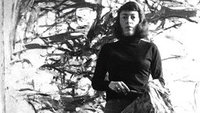 Joan Mitchell: Portrait of an Abstract Painter A powerful and intimate portrait, JOAN MITCHELL: PORTRAIT OF AN ABSTRACT PAINTER captures Mitchell's independent spirit and testifies eloquently to Mitchell's art. Joan Mitchell was born in Chicago in 1926 and died in Paris in 1992. After graduating from the School of the Art Institute of Chicago, Joan settled in New York City in 1950. She was an active participant of New York's dynamic Abstract Expressionist scene and hung out with fellow painters Franz Kline, Willem de Kooning and Philip Guston and, soon, poets Frank O'Hara, James Schuyler and John Ashbery. In the mid-fifties, she moved to Paris, France. There she was part of a circle of friends that included Pierre Matisse, Samuel Beckett and Alberto Giacometti. Mitchell is one of the great abstract painters of the 20th century.
Joan Mitchell: Portrait of an Abstract Painter A powerful and intimate portrait, JOAN MITCHELL: PORTRAIT OF AN ABSTRACT PAINTER captures Mitchell's independent spirit and testifies eloquently to Mitchell's art. Joan Mitchell was born in Chicago in 1926 and died in Paris in 1992. After graduating from the School of the Art Institute of Chicago, Joan settled in New York City in 1950. She was an active participant of New York's dynamic Abstract Expressionist scene and hung out with fellow painters Franz Kline, Willem de Kooning and Philip Guston and, soon, poets Frank O'Hara, James Schuyler and John Ashbery. In the mid-fifties, she moved to Paris, France. There she was part of a circle of friends that included Pierre Matisse, Samuel Beckett and Alberto Giacometti. Mitchell is one of the great abstract painters of the 20th century. -
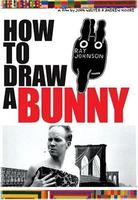 How to Draw a Bunny Ray Johnson was a mystery wrapped in an enigma who lived his life like a Pop Art performance piece. His final masterpiece may well have been his own death, in January 1995. This enthralling documentary – edited and directed by John Walter, photographed and produced by Andrew Moore – is at once playful and haunting, an in-depth portrait of an iconoclastic artist who was fundamentally unknowable even to his closest friends. Dubbed “the most famous unknown artist in America” in his time, Johnson is a prime example of the underground, eccentric genius who remains unknown to the public at large, while being legendary among his peers and others “in the know.” Many luminaries of the modern art world counted themselves fans and friends of Johnson, and “How to Draw a Bunny” features priceless interviews with such masters as Roy Lichtenstein, James Rosenquist, Chuck Close and Christo. Some marvel at the elusive complexity of Johnson’s art – a series of increasingly intricate letters to agent Mort Janklow is one example – while others conclude that he was most likely from another planet altogether. But none can separate the man from his work – his whole existence was his art, and his concepts of what an artwork could be were an (uncredited, of course) influence on the acknowledged father of Pop Art, one Andy Warhol. As Warhol Factory denizen Billy Name opines, “Ray wasn’t a person, he was a collage or a sculpture…he was Ray Johnson’s creation.” In the late ’80s, Johnson fortuitously added video to his palette. Some of that footage is included here, though much of it consists of Johnson going to a cocktail party, putting the guests on, making all of them part of his ongoing biographical “piece.” Johnson always seemed to have a sense of humor about what he was doing, and in the film he never once comes across as pretentious (as so much of the New York scene at the time did). This enigmatic whimsy extended to Johnson’s death, likely a suicide. His body was found floating under the Sag Harbor bridge, by buoy number 13. It was the 13th of January, and Johnson had stayed the night before in a motel, room number 247 (which adds up to 13). He was 67 at the time of his death (which also adds up to 13). In astounding video footage shot after his death, we see that Johnson had deliberately arranged his entire house to be discovered as his last great artwork, a meticulous warehouse of his ideas, his obsessions. Then again, maybe “How to Draw a Bunny” itself is really Ray Johnson’s final testament, created with a mischievous wink from beyond the grave. After watching this extraordinary documentary, one has no doubt that such an act is well within Johnson’s creative powers.
How to Draw a Bunny Ray Johnson was a mystery wrapped in an enigma who lived his life like a Pop Art performance piece. His final masterpiece may well have been his own death, in January 1995. This enthralling documentary – edited and directed by John Walter, photographed and produced by Andrew Moore – is at once playful and haunting, an in-depth portrait of an iconoclastic artist who was fundamentally unknowable even to his closest friends. Dubbed “the most famous unknown artist in America” in his time, Johnson is a prime example of the underground, eccentric genius who remains unknown to the public at large, while being legendary among his peers and others “in the know.” Many luminaries of the modern art world counted themselves fans and friends of Johnson, and “How to Draw a Bunny” features priceless interviews with such masters as Roy Lichtenstein, James Rosenquist, Chuck Close and Christo. Some marvel at the elusive complexity of Johnson’s art – a series of increasingly intricate letters to agent Mort Janklow is one example – while others conclude that he was most likely from another planet altogether. But none can separate the man from his work – his whole existence was his art, and his concepts of what an artwork could be were an (uncredited, of course) influence on the acknowledged father of Pop Art, one Andy Warhol. As Warhol Factory denizen Billy Name opines, “Ray wasn’t a person, he was a collage or a sculpture…he was Ray Johnson’s creation.” In the late ’80s, Johnson fortuitously added video to his palette. Some of that footage is included here, though much of it consists of Johnson going to a cocktail party, putting the guests on, making all of them part of his ongoing biographical “piece.” Johnson always seemed to have a sense of humor about what he was doing, and in the film he never once comes across as pretentious (as so much of the New York scene at the time did). This enigmatic whimsy extended to Johnson’s death, likely a suicide. His body was found floating under the Sag Harbor bridge, by buoy number 13. It was the 13th of January, and Johnson had stayed the night before in a motel, room number 247 (which adds up to 13). He was 67 at the time of his death (which also adds up to 13). In astounding video footage shot after his death, we see that Johnson had deliberately arranged his entire house to be discovered as his last great artwork, a meticulous warehouse of his ideas, his obsessions. Then again, maybe “How to Draw a Bunny” itself is really Ray Johnson’s final testament, created with a mischievous wink from beyond the grave. After watching this extraordinary documentary, one has no doubt that such an act is well within Johnson’s creative powers. -
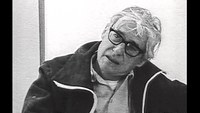 Painter's Painting Documentary exploring the gravitational shift of art influence from Europe to America, beginning with Abstract Expressionism, moving on to Pop Art and later, Minimalism. With Willem de Kooning, Jasper Johns, Andy Warhol, Jackson Pollock, Robert Rauschenberg and others.
Painter's Painting Documentary exploring the gravitational shift of art influence from Europe to America, beginning with Abstract Expressionism, moving on to Pop Art and later, Minimalism. With Willem de Kooning, Jasper Johns, Andy Warhol, Jackson Pollock, Robert Rauschenberg and others. -
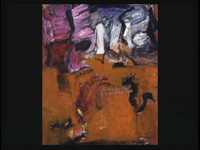 Meet the Artist: Grace Hartigan Grace Hartigan grew up in New Jersey, where she married the boy next door after graduating from high school. They ended up penniless in Los Angeles, however, and Hartigan returned to the East Coast pregnant and alone. In 1948 she was mesmerized and fascinated by a Jackson Pollock exhibition and lived briefly on Long Island with the artist and his wife. She worked odd jobs in New York through the 1950s to pay for paint. In 1959, Hartigan married Dr. Winston Price and moved with him to Baltimore, where she worked in a large studio in Fells Point for decades. (Mattison, Grace Hartigan: A Painters World, 1990)
Meet the Artist: Grace Hartigan Grace Hartigan grew up in New Jersey, where she married the boy next door after graduating from high school. They ended up penniless in Los Angeles, however, and Hartigan returned to the East Coast pregnant and alone. In 1948 she was mesmerized and fascinated by a Jackson Pollock exhibition and lived briefly on Long Island with the artist and his wife. She worked odd jobs in New York through the 1950s to pay for paint. In 1959, Hartigan married Dr. Winston Price and moved with him to Baltimore, where she worked in a large studio in Fells Point for decades. (Mattison, Grace Hartigan: A Painters World, 1990) -
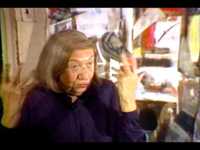 Inside New York's Art World: Lee Krasner Barbaralee Diamonstein-Spielvogel interviews Lee Krasner concerning her works, career, and the artists she knows, as hosted by the Duke University Libraries.
Inside New York's Art World: Lee Krasner Barbaralee Diamonstein-Spielvogel interviews Lee Krasner concerning her works, career, and the artists she knows, as hosted by the Duke University Libraries. -
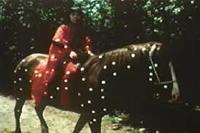 Kusama's Self-Obliteration 1968 film by Japanese artist Yayoi Kusama and the late experimental filmmaker Jud Yalkut. Kusama produces and stars in the film, which has a psychedelic feel and non-narrative structure. It starts with Kusama in rural upstate New York, covering animals, plants and a naked male body with polka dots. She uses this action throughout her career as a metaphor for giving up identity, abolishing uniqueness and becoming one with the universe - or 'self-obliteration'. The film goes on to show body-painting in the artist's installation environments or 'happenings'. These 'happenings' embraced the new hippie culture that had been on the rise in the US since the mid-60s, as well as sexual liberation, opposition to the Vietnam War and a yearning for change following civil rights injustices. They also saw a shift in art with a move away from the restraints of the gallery space and its conventions of traditional painting and sculpture. Kusama's 'happenings' took place in New York parks and public spaces such as Central Park and Brooklyn Bridge, as well as in galleries, and would often involve audio-visual-light performances where she painted naked models with paints or covered them in polka dots. The film was so popular in art-house film circles that Kusama set up a company to sell prints from the film. It also went on to win prizes in the Fourth International Experimental Film Competition in Belgium as well as the Maryland and Ann Arbor Film Festivals in the US.
Kusama's Self-Obliteration 1968 film by Japanese artist Yayoi Kusama and the late experimental filmmaker Jud Yalkut. Kusama produces and stars in the film, which has a psychedelic feel and non-narrative structure. It starts with Kusama in rural upstate New York, covering animals, plants and a naked male body with polka dots. She uses this action throughout her career as a metaphor for giving up identity, abolishing uniqueness and becoming one with the universe - or 'self-obliteration'. The film goes on to show body-painting in the artist's installation environments or 'happenings'. These 'happenings' embraced the new hippie culture that had been on the rise in the US since the mid-60s, as well as sexual liberation, opposition to the Vietnam War and a yearning for change following civil rights injustices. They also saw a shift in art with a move away from the restraints of the gallery space and its conventions of traditional painting and sculpture. Kusama's 'happenings' took place in New York parks and public spaces such as Central Park and Brooklyn Bridge, as well as in galleries, and would often involve audio-visual-light performances where she painted naked models with paints or covered them in polka dots. The film was so popular in art-house film circles that Kusama set up a company to sell prints from the film. It also went on to win prizes in the Fourth International Experimental Film Competition in Belgium as well as the Maryland and Ann Arbor Film Festivals in the US. -
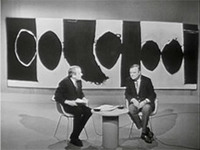 On the ethical character of art Motherwell discusses the ethical character of art in this segment of the 1964 public television program ART: New York.
On the ethical character of art Motherwell discusses the ethical character of art in this segment of the 1964 public television program ART: New York.